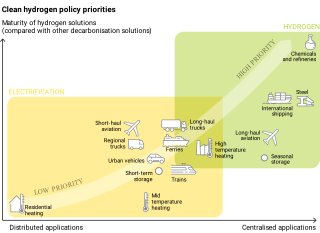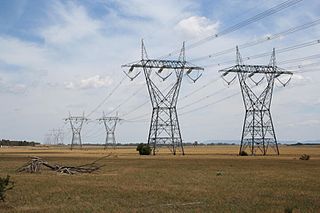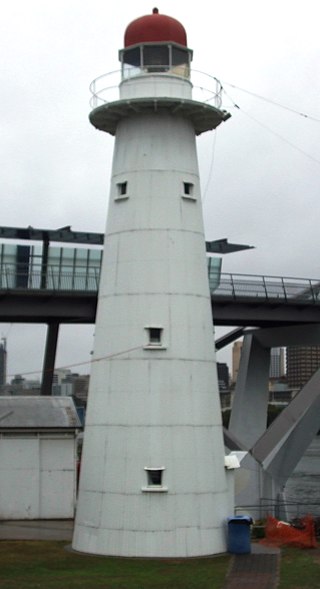
There are many forms of transport in Australia. Australia is highly dependent on road transport. There are more than 300 airports with paved runways. Passenger rail transport includes widespread commuter networks in the major capital cities with more limited intercity and interstate networks. The Australian mining sector is reliant upon rail to transport its product to Australia's ports for export.

Fort Lytton National Park is a national park in Lytton, City of Brisbane, Queensland, Australia. Its main attraction is Fort Lytton Historic Military Precinct, providing guided tours of historic Fort Lytton, a museum and re-enactments. The park was created in 1990 as Queensland's first historic national park. It initially contained only heritage-listed Fort Lytton, a colonial coastal fort that continued to operate as a military base until after the Second World War. The park was extended in 1999 to include Lytton Quarantine Station which occupied adjacent land. The Quarantine Station is also heritage-listed, but is only open to the public on special occasions.

Gheebulum Kunungai is a national park which covers 98% of Moreton Island (Mulgumpin) in Queensland, Australia, 40 km northeast of center of the Brisbane. Its eastern part of he City of Brisbane. It has three main townships, Bulwer, Cowan Cowan and Kooringal.

The hydrogen economy is an umbrella term for the roles hydrogen can play alongside low-carbon electricity to reduce emissions of greenhouse gases. The aim is to reduce emissions where cheaper and more energy-efficient clean solutions are not available. In this context, hydrogen economy encompasses the production of hydrogen and the use of hydrogen in ways that contribute to phasing-out fossil fuels and limiting climate change.

Santos Ltd. is an Australian oil and gas exploration and production company, with its headquarters in Adelaide, South Australia. It owns liquefied natural gas (LNG), pipeline gas, and oil assets. It is the biggest supplier of natural gas in Australia, with its plants in the Cooper Basin in South Australia and South West Queensland supplying the eastern states of Australia. Its operations also extend to the seas off Western Australia and Northern Territory.

Pinkenba is a town and eastern coastal suburb within the City of Brisbane, Queensland, Australia. In the 2021 census, Pinkenba had a population of 350 people.

Ampol Limited is an Australian petroleum company headquartered in Sydney, New South Wales. Ampol is the largest transport energy distributor and retailer in Australia, with more than 1,900 Ampol-branded stations across the country as of October 2022. Ampol also operates in New Zealand through its subsidiary Z Energy.

Lytton is an outer riverside suburb in the City of Brisbane, Queensland, Australia. In the 2021 census, Lytton had "no people or a very low population".

Renewable energy in Australia is mainly based on biomass, solar, wind, and hydro generation. Over a third of electricity is generated from renewables, and is increasing, with a target to phase out coal power before 2040. Wind energy and rooftop solar have particularly grown since 2010. The growth has been stimulated by government energy policy in order to limit the rate of climate change in Australia that has been brought about by the use of fossil fuels. Pros and cons of various types of renewable energy are being investigated, and more recently there have been trials of green hydrogen and wave power.

Energy in Victoria, Australia is generated using a number of fuels or technologies, including coal, natural gas and renewable energy sources. Brown coal, historically, was the main primary energy source for the generation of electricity in the state, accounting for about 85% of electricity generation in 2008. The amount of coal-fired power has decreased significantly with the closure in 2017 of the Hazelwood power station which supplied around 20% of Victoria's electricity, and to a lesser extent with the exit of Anglesea power station in 2015. Brown coal is one of the largest contributors to Australia's total domestic greenhouse gas emissions and a source of controversy for the country. Australia is one of the highest polluters of greenhouse gas per capita in the world.

Queensland's energy policy is based on the year 2000 document called the Queensland Energy Policy: A Cleaner Energy Strategy. The Queensland Government assists energy development through the Department of Energy and Water Supply. The state is noted for its significant contribution to coal mining in Australia. The primary fuel for electricity generation in the state is coal with coal seam gas becoming a significant fuel source. Queensland has 98% of Australia's reserves of coal seam gas. An expansion of energy-intensive industries such as mining, economic growth and population growth have created increased demand for energy in Queensland.

The petroleum industry in Western Australia is the largest contributor to the country's petroleum exports. Western Australia's North West Shelf (NWS) is the primary location from which production originates. Oil exports are shipped from Port Hedland.

Bulwer Island is a 120 hectares (1.2 km2) reclaimed tidal mangrove island at the mouth of the Brisbane River in the suburb of Pinkenba, Brisbane, Queensland, Australia. It is named for Sir Edward Bulwer-Lytton, the British Colonial Secretary who separated Queensland from New South Wales in 1859 and made Sir George Bowen its first Governor.
Bulwer Island Refinery was an oil refinery on Bulwer Island near the mouth of the Brisbane River in Queensland, Australia. It is now a petroleum import and storage terminal. It was built by Amoco in the 1960s, taken over by BP in 1984 and converted to an import terminal in 2015. It occupies much of the former island. While it operated, it was the largest oil refinery in Queensland.

Bulwer Island Light, also known as Bulwer Island Range Rear Light, is an inactive lighthouse that was on Bulwer Island, in the suburb of Pinkenba, City of Brisbane, Queensland, Australia. In 1983, it was moved to the Queensland Maritime Museum in South Brisbane.

The Kwinana Oil Refinery was sited on the shore of Cockburn Sound at the suburb of Kwinana Beach, near Fremantle, Western Australia. Built by the Anglo-Iranian Oil Company and completed in 1955, it was the largest oil refinery in Australia, with a capacity of 21.9 million litres per day (138,000 bbl/d). It was closed by BP in March 2021 to be converted to an import-only terminal.

Lytton Hill is a heritage-listed signal station via South Street, Lytton, City of Brisbane, Queensland, Australia. It was built from 1859 to c. 1945. It is also known as Lytton Redoubt, Reformatory, and Signal Hill. It was added to the Queensland Heritage Register on 25 August 2000.

Viva Energy Australia is a listed Australian company that owns the Geelong Oil Refinery and is licensed to retail Shell-branded fuels across Australia under a licence agreement. It also owns and retails fuel through Coles Express, OTR, Reddy Express, Liberty Oil and Westside Petroleum-branded service stations. In total, Viva Energy supplies a network of over 1,330 retail fuel outlets across Australia, supported by an extensive import, storage and distribution infrastructure network, including a presence at over 70 airports and airfields. In addition to manufacturing a range of fuel and other products at the Geelong Refinery, Viva Energy imports fuel supplied by Vitol through 24 fuel import terminals across Australia.
The Geelong Oil Refinery is an oil refinery owned and operated by Viva Energy in Corio near Geelong in the Australian state of Victoria. In 2017, it was Australia's second-largest oil refinery, able to process 7.5 billion litres of crude oil per year.
Australia is a major petroleum producer and importer, with a number of petroleum companies involved in upstream and downstream operations. Western Australia is the largest contributor to Australia's production of most petroleum products.
















